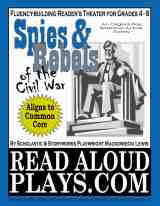 If you’ve never heard one of your students attempt a southern drawl you must give Box Brown’s Freedom Crate a whirl during Black History Month. Ever since I wrote it for Scholastic’s Storyworks magazine back 1999, Box Brown has always been a favorite among my students. Consequently my class learns and performs it almost every year. Even if you’re teaching in the Southern U.S.—where the dialect might not be so unique—there remain many compelling reasons to teach with this play.
If you’ve never heard one of your students attempt a southern drawl you must give Box Brown’s Freedom Crate a whirl during Black History Month. Ever since I wrote it for Scholastic’s Storyworks magazine back 1999, Box Brown has always been a favorite among my students. Consequently my class learns and performs it almost every year. Even if you’re teaching in the Southern U.S.—where the dialect might not be so unique—there remain many compelling reasons to teach with this play.
Box Brown’s Freedom Crate is based on The Autobiography of Henry “Box” Brown. Henry was the slave who mailed himself to the North inside a wooden crate and lived—just barely—to tell the world about it. Why do kids like this play so much? The large cardboard box we use as the main prop is one reason It’s painted to look like an old-fashioned shipping crate and is just big enough for a moderately-sized fifth grader to climb inside. The student playing Henry disappears within it during Scene 4 and then discreetly exits while the curtains are closed. From there he appears to get battered as the box is tossed from wagon to train to steamer until it finally gets cracked open at the Anti-Slavery Society in Philadelphia. Henry then rises from his coffin only to quickly swoon away from exhaustion and dehydration. This is of course a dramatic moment in Henry’s true story, and one kids don’t soon forget.
There are also sound academic reasons to enact plays such as Box Brown’s Freedom Crate. For example, because kids are willing to read and reread their lines over and over again, Read Aloud Plays build reading fluency. The brain science behind this repetition suggests it actually forms the neural pathways that make reading possible. Read Aloud Plays are easily leveled and they provide the exposure to drama the new Common Core Standards demand. They also allow students to experience history “first hand,” which helps them to relate to people like Henry, to understand some of the heartache and suffering Henry might have felt. …Plus there’s still that whole southern accent thing.
Visit my storefront at TeachersPayTeachers to download a free preview of Box Brown or one of my other Black History plays about such important events and people as Ruby Bridges, Claudette Colvin, and the Day of Jubilee. I’ve used every one in my own classroom, and because most have been previously published in Scholastic classroom magazines, you can rest-assured they’re of the highest quality.
Box Brown’s Freedom Crate is suitable for 4th-8th graders and includes parts for from ten to twenty students depending on your needs. Hear Box Brown being performed by students by clicking on the “podcasts” tab, and to get the most out of your reader’s theater, be sure to download my free article entitled “Why Use Drama?” Happy directing!







